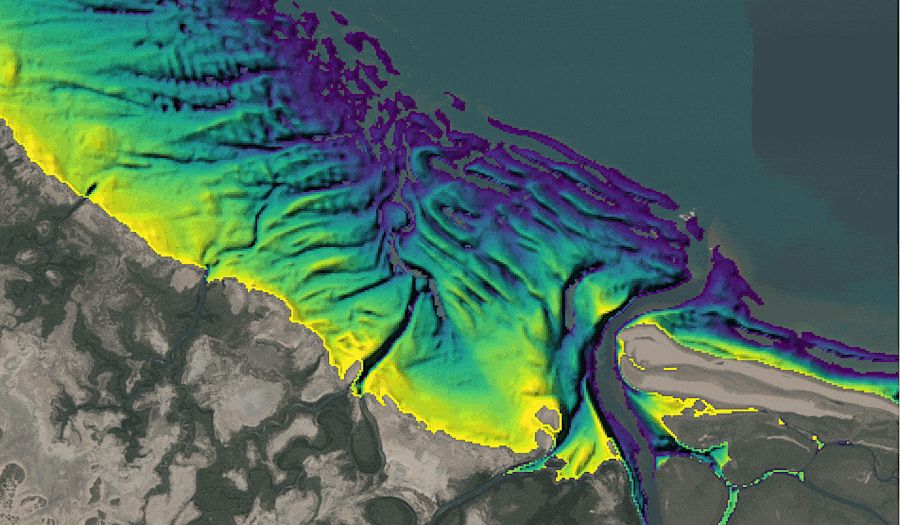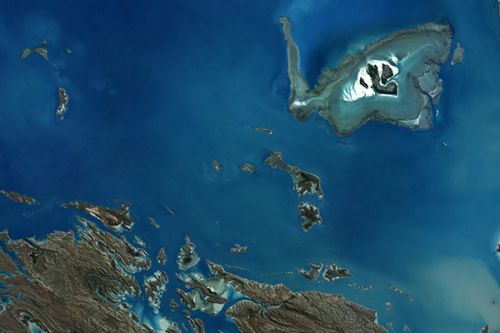Understanding the coastal zone’s multiple dimensions with DEA Intertidal product suite
Page last updated:18 June 2024
Digital Earth Australia (DEA) has launched a new intertidal product suite that will help better characterise and understand the strand between land and sea, including the ability to map this complex zone in multiple dimensions.
DEA’s intertidal products have been used across government and industry. With the release of our next generation product suite, DEA Intertidal, it will become the first DEA product to incorporate Landsat and Sentinel-2 data.
DEA Intertidal maps the changing elevation, exposure and tidal characteristics of Australia’s exposed intertidal zone. The product suite provides an annual 10m resolution elevation product for the intertidal zone, enabling users to better monitor and understand some of the most dynamic regions of Australia’s coastlines.
Before and after: See the enhanced detail in this comparison between the timeseries models of DEA Intertidal Elevation Model (also known as the National Intertidal Digital Elevation Model or NIDEM) and the new DEA Intertidal.
DEA Intertidal core product layers (left to right): Elevation, with low elevation values shown in dark colours and high elevation shown in light colours; Elevation Uncertainty, with high uncertainty shown in light colours, and; DEA Intertidal Exposure, showing percentage of time regions of the intertidal zone are exposed, with low exposure values (i.e. rarely exposed pixels) shown in dark colours.
“Our latest product suite adds a temporal component to the elevation product for the intertidal zone,” said Stephen Sagar, manager of the Coastal Environments team in DEA.
“That means DEA Intertidal will enable users to better monitor and understand some of the most dynamic regions of Australia’s coastlines.”
Utilising an improved tidal modelling capability, the product suite includes continental-scale mapping of intertidal exposure over time, enabling scientists and managers to integrate the data into ecological and migratory species applications and modelling. This kind of data can shed light on the changing extents and availability of foraging grounds for endangered species, such as migratory shore birds that use Australian intertidal mudflats as a stopover on global migrations.
Earlier iterations of the DEA Intertidal products, such as the DEA Intertidal Elevation Model (also known as the National Intertidal Digital Elevation Model or NIDEM), are already widely used to measure the interface between land and sea, a highly dynamic and difficult to access zone. NIDEM was the first 3D model of Australia’s intertidal zone.
DEA Intertidal Elevation mapped across Dugong Bay in the Kimberley, Western Australia (left) and an aerial view of Dugong Bay (right).
With the new time series data included in our latest product suite, DEA Intertidal can assist with understanding how Australia’s coastlines have changed over time, and potentially how they will continue to evolve into the future.
“DEA Intertidal will provide baseline elevation data to monitor changing patterns of erosion and sediment movement, and coastal hazard impacts from extreme weather and inundation events,” said Robbi Bishop-Taylor, co-lead of the project from the Coastal Environments team in DEA.
Australian intertidal areas support a vast array of habitats and species that are dependent on the conditions of these unique environments. The DEA Intertidal product suite has been expanded to include continental-scale mapping of intertidal exposure over time, enabling scientists and managers to integrate the data into ecological and migratory species applications and modelling.
“Intertidal environments are diverse and contain many important ecological habitats such as sandy beaches, tidal flats, rocky shores, and reefs,” said Claire Phillips, co-lead of the project, adding that the environments also provide many valuable benefits such as carbon storage and natural resources.
Seven years of migrating sand banks and tidal flats near Cape Capricorn, Queensland. You can use DEA Intertidal to create 3D maps over time to examine these ever-changing environments. Compared with earlier static versions of our Intertidal products, we can now visualise the shifting sands of these dynamic regions of Australia’s coast.
Intertidal zones face increased threats from natural and man-made influences, including coastal erosion, land reclamation such as port construction, and sea level rise. Given this region is already in constant flux, DEA Intertidal is a necessary tool for recording and understanding these changes with accurate, up-to-date elevation data describing the changing topography and extent of these environments.
DEA Intertidal interactive map
Visit DEA Maps to get the full interactive map with DEA Intertidal and other DEA products.
Other advances delivered with DEA Intertidal
The DEA Intertidal product suite is the next generation of intertidal products developed in DEA. It combines data from both Landsat and Sentinel-2 satellite sensors, leveraging our approach of combining time-series Earth observation data with tidal modelling to create continental-scale products for the intertidal region, and supersedes the DEA Intertidal Elevation Model (NIDEM). The DEA Intertidal suite fundamentally changes the way the intertidal zone is modelled when compared to the original NIDEM elevation model. Improvements include:
- The addition of Sentinel-2 data which improves the spatial resolution of the model to 10m, compared to the 25 m of the original NIDEM.
- Incorporation of a new pixel-based method that supports a reduction in the temporal epoch of the product to 3 years (in comparison to 28 years in NIDEM), improving the ability to capture the current state of dynamic coastal environments, and enabling ‘change-over-time' applications using annual epochs.
- Quantification of the vertical uncertainty of the elevation model.
- An Intertidal Exposure model at 10 m resolution to examine the spatiotemporal patterns of exposure and inundation across the intertidal zone, supporting migratory species studies and habitat mapping applications.
- Tidal metrics to enable users to understand the varied ranges and distributions of tidal stages observed by the Landsat and Sentinel-2 satellites across Australia, and how this information can be used to better understand and interpret the products.
- The implementation of an ensemble tidal modelling approach, acknowledging the wide range of global and regional tide models available and their varying performance across different regions of Australia.
How to access
Questions and feedback
We welcome your questions and ongoing input into the development of DEA Intertidal product suite. Please contact us with any feedback or troubleshooting concerns at earth.observation@ga.gov.au












